Human Resource Management: JP Morgan HRM Practices Analysis Report
VerifiedAdded on 2020/12/18
|16
|5419
|436
Report
AI Summary
This report delves into the realm of Human Resource Management (HRM), exploring its purpose, functions, and diverse practices. The report commences by outlining the core objectives and operational aspects of HRM, emphasizing its significance in organizational strategy and employee development. It then investigates the strengths and weaknesses of various recruitment and selection approaches, including internal and external methods. The report further examines the advantages of HRM practices for both employees and employers, highlighting the importance of compensation, benefits, and training programs. Additionally, it evaluates the effectiveness of HRM in boosting profit and productivity, as well as the significance of employee relations and employment legislation in decision-making processes. The report concludes with an examination of the application of HRM practices in a work-related context, providing a comprehensive analysis of its impact on organizational success, with a particular focus on the practices within JP Morgan.
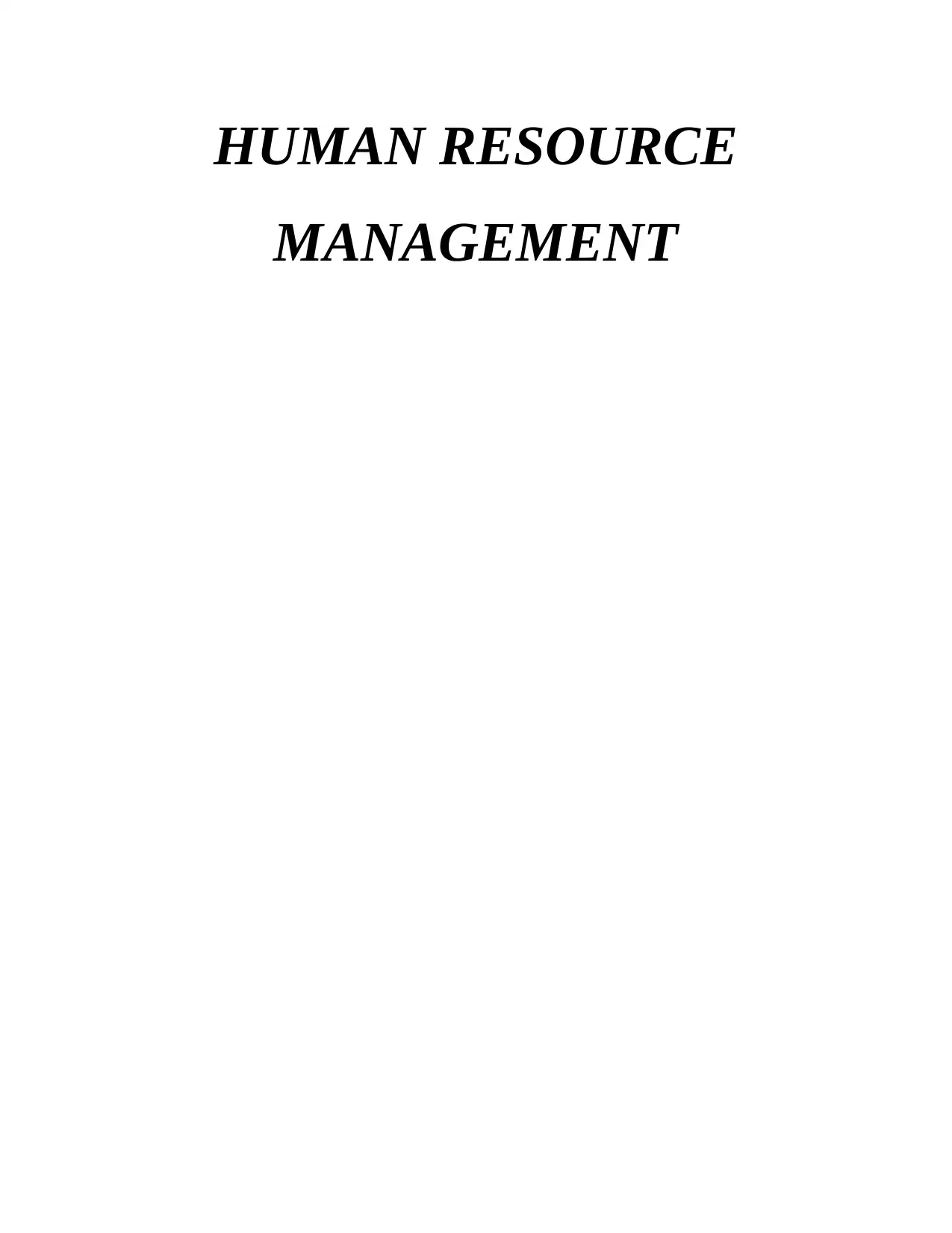
HUMAN RESOURCE
MANAGEMENT
MANAGEMENT
Paraphrase This Document
Need a fresh take? Get an instant paraphrase of this document with our AI Paraphraser

Contents
INTRODUCTION...........................................................................................................................1
TASK 1............................................................................................................................................1
P1. The purpose as well as functions of Human Resource Management ...................................1
P2. Strength and weaknesses of different approaches to recruitment and selection....................3
TASK 2............................................................................................................................................4
P3 Benefits of HRM practices to employee and employer..........................................................4
P4 Effectiveness of HRM practices in terms of raising profit and productivity..........................6
TASK 3............................................................................................................................................7
P5 Significance of good employee relation and its influence on decision making.....................7
P6 Components of employment legislation and its influence on decision making of HRM.......9
TASK 4..........................................................................................................................................10
P7 Application of human resource management practices in work related context..................10
CONCLUSION..............................................................................................................................13
REFERENCES..............................................................................................................................14
INTRODUCTION...........................................................................................................................1
TASK 1............................................................................................................................................1
P1. The purpose as well as functions of Human Resource Management ...................................1
P2. Strength and weaknesses of different approaches to recruitment and selection....................3
TASK 2............................................................................................................................................4
P3 Benefits of HRM practices to employee and employer..........................................................4
P4 Effectiveness of HRM practices in terms of raising profit and productivity..........................6
TASK 3............................................................................................................................................7
P5 Significance of good employee relation and its influence on decision making.....................7
P6 Components of employment legislation and its influence on decision making of HRM.......9
TASK 4..........................................................................................................................................10
P7 Application of human resource management practices in work related context..................10
CONCLUSION..............................................................................................................................13
REFERENCES..............................................................................................................................14
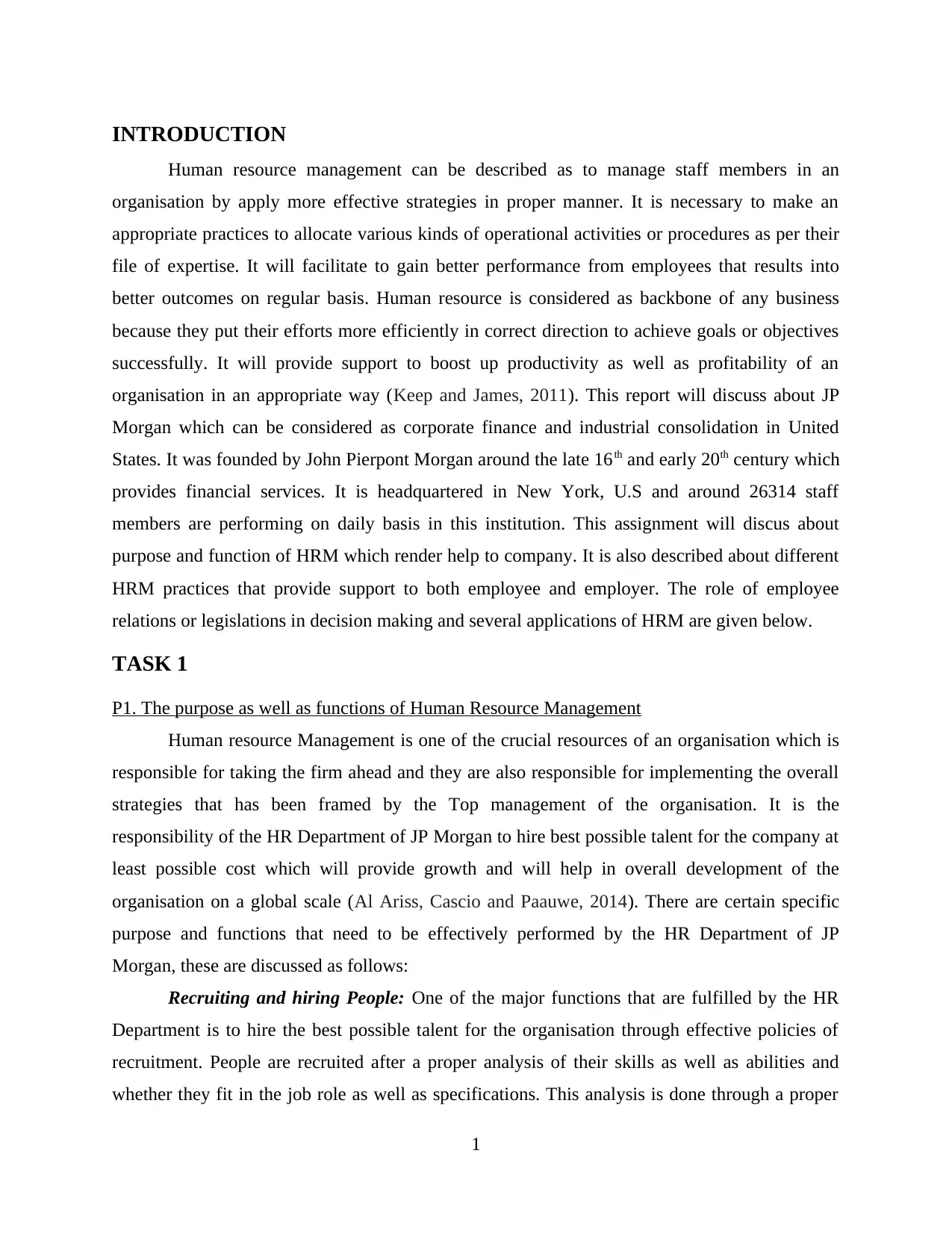
INTRODUCTION
Human resource management can be described as to manage staff members in an
organisation by apply more effective strategies in proper manner. It is necessary to make an
appropriate practices to allocate various kinds of operational activities or procedures as per their
file of expertise. It will facilitate to gain better performance from employees that results into
better outcomes on regular basis. Human resource is considered as backbone of any business
because they put their efforts more efficiently in correct direction to achieve goals or objectives
successfully. It will provide support to boost up productivity as well as profitability of an
organisation in an appropriate way (Keep and James, 2011). This report will discuss about JP
Morgan which can be considered as corporate finance and industrial consolidation in United
States. It was founded by John Pierpont Morgan around the late 16th and early 20th century which
provides financial services. It is headquartered in New York, U.S and around 26314 staff
members are performing on daily basis in this institution. This assignment will discus about
purpose and function of HRM which render help to company. It is also described about different
HRM practices that provide support to both employee and employer. The role of employee
relations or legislations in decision making and several applications of HRM are given below.
TASK 1
P1. The purpose as well as functions of Human Resource Management
Human resource Management is one of the crucial resources of an organisation which is
responsible for taking the firm ahead and they are also responsible for implementing the overall
strategies that has been framed by the Top management of the organisation. It is the
responsibility of the HR Department of JP Morgan to hire best possible talent for the company at
least possible cost which will provide growth and will help in overall development of the
organisation on a global scale (Al Ariss, Cascio and Paauwe, 2014). There are certain specific
purpose and functions that need to be effectively performed by the HR Department of JP
Morgan, these are discussed as follows:
Recruiting and hiring People: One of the major functions that are fulfilled by the HR
Department is to hire the best possible talent for the organisation through effective policies of
recruitment. People are recruited after a proper analysis of their skills as well as abilities and
whether they fit in the job role as well as specifications. This analysis is done through a proper
1
Human resource management can be described as to manage staff members in an
organisation by apply more effective strategies in proper manner. It is necessary to make an
appropriate practices to allocate various kinds of operational activities or procedures as per their
file of expertise. It will facilitate to gain better performance from employees that results into
better outcomes on regular basis. Human resource is considered as backbone of any business
because they put their efforts more efficiently in correct direction to achieve goals or objectives
successfully. It will provide support to boost up productivity as well as profitability of an
organisation in an appropriate way (Keep and James, 2011). This report will discuss about JP
Morgan which can be considered as corporate finance and industrial consolidation in United
States. It was founded by John Pierpont Morgan around the late 16th and early 20th century which
provides financial services. It is headquartered in New York, U.S and around 26314 staff
members are performing on daily basis in this institution. This assignment will discus about
purpose and function of HRM which render help to company. It is also described about different
HRM practices that provide support to both employee and employer. The role of employee
relations or legislations in decision making and several applications of HRM are given below.
TASK 1
P1. The purpose as well as functions of Human Resource Management
Human resource Management is one of the crucial resources of an organisation which is
responsible for taking the firm ahead and they are also responsible for implementing the overall
strategies that has been framed by the Top management of the organisation. It is the
responsibility of the HR Department of JP Morgan to hire best possible talent for the company at
least possible cost which will provide growth and will help in overall development of the
organisation on a global scale (Al Ariss, Cascio and Paauwe, 2014). There are certain specific
purpose and functions that need to be effectively performed by the HR Department of JP
Morgan, these are discussed as follows:
Recruiting and hiring People: One of the major functions that are fulfilled by the HR
Department is to hire the best possible talent for the organisation through effective policies of
recruitment. People are recruited after a proper analysis of their skills as well as abilities and
whether they fit in the job role as well as specifications. This analysis is done through a proper
1
⊘ This is a preview!⊘
Do you want full access?
Subscribe today to unlock all pages.

Trusted by 1+ million students worldwide
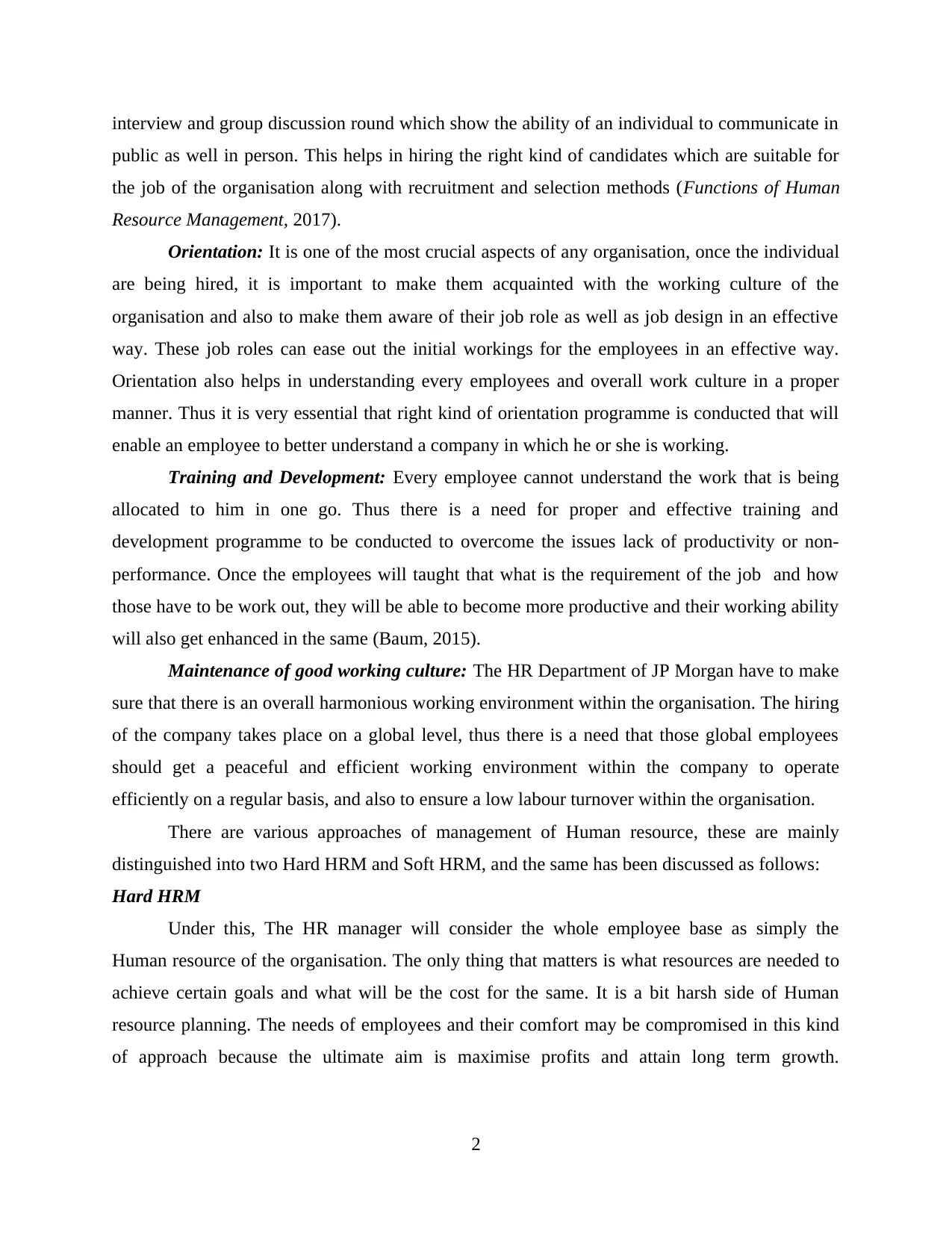
interview and group discussion round which show the ability of an individual to communicate in
public as well in person. This helps in hiring the right kind of candidates which are suitable for
the job of the organisation along with recruitment and selection methods (Functions of Human
Resource Management, 2017).
Orientation: It is one of the most crucial aspects of any organisation, once the individual
are being hired, it is important to make them acquainted with the working culture of the
organisation and also to make them aware of their job role as well as job design in an effective
way. These job roles can ease out the initial workings for the employees in an effective way.
Orientation also helps in understanding every employees and overall work culture in a proper
manner. Thus it is very essential that right kind of orientation programme is conducted that will
enable an employee to better understand a company in which he or she is working.
Training and Development: Every employee cannot understand the work that is being
allocated to him in one go. Thus there is a need for proper and effective training and
development programme to be conducted to overcome the issues lack of productivity or non-
performance. Once the employees will taught that what is the requirement of the job and how
those have to be work out, they will be able to become more productive and their working ability
will also get enhanced in the same (Baum, 2015).
Maintenance of good working culture: The HR Department of JP Morgan have to make
sure that there is an overall harmonious working environment within the organisation. The hiring
of the company takes place on a global level, thus there is a need that those global employees
should get a peaceful and efficient working environment within the company to operate
efficiently on a regular basis, and also to ensure a low labour turnover within the organisation.
There are various approaches of management of Human resource, these are mainly
distinguished into two Hard HRM and Soft HRM, and the same has been discussed as follows:
Hard HRM
Under this, The HR manager will consider the whole employee base as simply the
Human resource of the organisation. The only thing that matters is what resources are needed to
achieve certain goals and what will be the cost for the same. It is a bit harsh side of Human
resource planning. The needs of employees and their comfort may be compromised in this kind
of approach because the ultimate aim is maximise profits and attain long term growth.
2
public as well in person. This helps in hiring the right kind of candidates which are suitable for
the job of the organisation along with recruitment and selection methods (Functions of Human
Resource Management, 2017).
Orientation: It is one of the most crucial aspects of any organisation, once the individual
are being hired, it is important to make them acquainted with the working culture of the
organisation and also to make them aware of their job role as well as job design in an effective
way. These job roles can ease out the initial workings for the employees in an effective way.
Orientation also helps in understanding every employees and overall work culture in a proper
manner. Thus it is very essential that right kind of orientation programme is conducted that will
enable an employee to better understand a company in which he or she is working.
Training and Development: Every employee cannot understand the work that is being
allocated to him in one go. Thus there is a need for proper and effective training and
development programme to be conducted to overcome the issues lack of productivity or non-
performance. Once the employees will taught that what is the requirement of the job and how
those have to be work out, they will be able to become more productive and their working ability
will also get enhanced in the same (Baum, 2015).
Maintenance of good working culture: The HR Department of JP Morgan have to make
sure that there is an overall harmonious working environment within the organisation. The hiring
of the company takes place on a global level, thus there is a need that those global employees
should get a peaceful and efficient working environment within the company to operate
efficiently on a regular basis, and also to ensure a low labour turnover within the organisation.
There are various approaches of management of Human resource, these are mainly
distinguished into two Hard HRM and Soft HRM, and the same has been discussed as follows:
Hard HRM
Under this, The HR manager will consider the whole employee base as simply the
Human resource of the organisation. The only thing that matters is what resources are needed to
achieve certain goals and what will be the cost for the same. It is a bit harsh side of Human
resource planning. The needs of employees and their comfort may be compromised in this kind
of approach because the ultimate aim is maximise profits and attain long term growth.
2
Paraphrase This Document
Need a fresh take? Get an instant paraphrase of this document with our AI Paraphraser
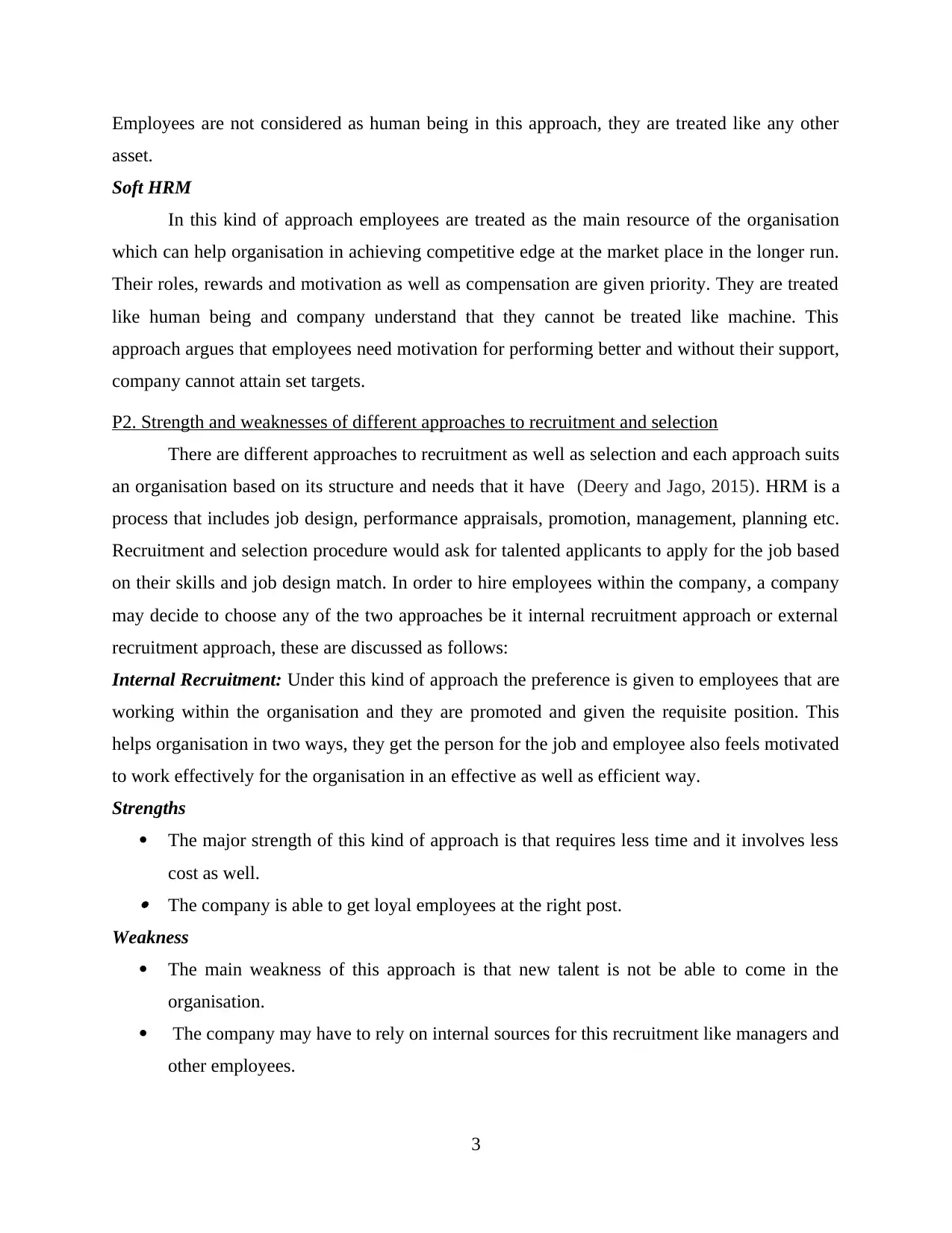
Employees are not considered as human being in this approach, they are treated like any other
asset.
Soft HRM
In this kind of approach employees are treated as the main resource of the organisation
which can help organisation in achieving competitive edge at the market place in the longer run.
Their roles, rewards and motivation as well as compensation are given priority. They are treated
like human being and company understand that they cannot be treated like machine. This
approach argues that employees need motivation for performing better and without their support,
company cannot attain set targets.
P2. Strength and weaknesses of different approaches to recruitment and selection
There are different approaches to recruitment as well as selection and each approach suits
an organisation based on its structure and needs that it have (Deery and Jago, 2015). HRM is a
process that includes job design, performance appraisals, promotion, management, planning etc.
Recruitment and selection procedure would ask for talented applicants to apply for the job based
on their skills and job design match. In order to hire employees within the company, a company
may decide to choose any of the two approaches be it internal recruitment approach or external
recruitment approach, these are discussed as follows:
Internal Recruitment: Under this kind of approach the preference is given to employees that are
working within the organisation and they are promoted and given the requisite position. This
helps organisation in two ways, they get the person for the job and employee also feels motivated
to work effectively for the organisation in an effective as well as efficient way.
Strengths
The major strength of this kind of approach is that requires less time and it involves less
cost as well. The company is able to get loyal employees at the right post.
Weakness
The main weakness of this approach is that new talent is not be able to come in the
organisation.
The company may have to rely on internal sources for this recruitment like managers and
other employees.
3
asset.
Soft HRM
In this kind of approach employees are treated as the main resource of the organisation
which can help organisation in achieving competitive edge at the market place in the longer run.
Their roles, rewards and motivation as well as compensation are given priority. They are treated
like human being and company understand that they cannot be treated like machine. This
approach argues that employees need motivation for performing better and without their support,
company cannot attain set targets.
P2. Strength and weaknesses of different approaches to recruitment and selection
There are different approaches to recruitment as well as selection and each approach suits
an organisation based on its structure and needs that it have (Deery and Jago, 2015). HRM is a
process that includes job design, performance appraisals, promotion, management, planning etc.
Recruitment and selection procedure would ask for talented applicants to apply for the job based
on their skills and job design match. In order to hire employees within the company, a company
may decide to choose any of the two approaches be it internal recruitment approach or external
recruitment approach, these are discussed as follows:
Internal Recruitment: Under this kind of approach the preference is given to employees that are
working within the organisation and they are promoted and given the requisite position. This
helps organisation in two ways, they get the person for the job and employee also feels motivated
to work effectively for the organisation in an effective as well as efficient way.
Strengths
The major strength of this kind of approach is that requires less time and it involves less
cost as well. The company is able to get loyal employees at the right post.
Weakness
The main weakness of this approach is that new talent is not be able to come in the
organisation.
The company may have to rely on internal sources for this recruitment like managers and
other employees.
3
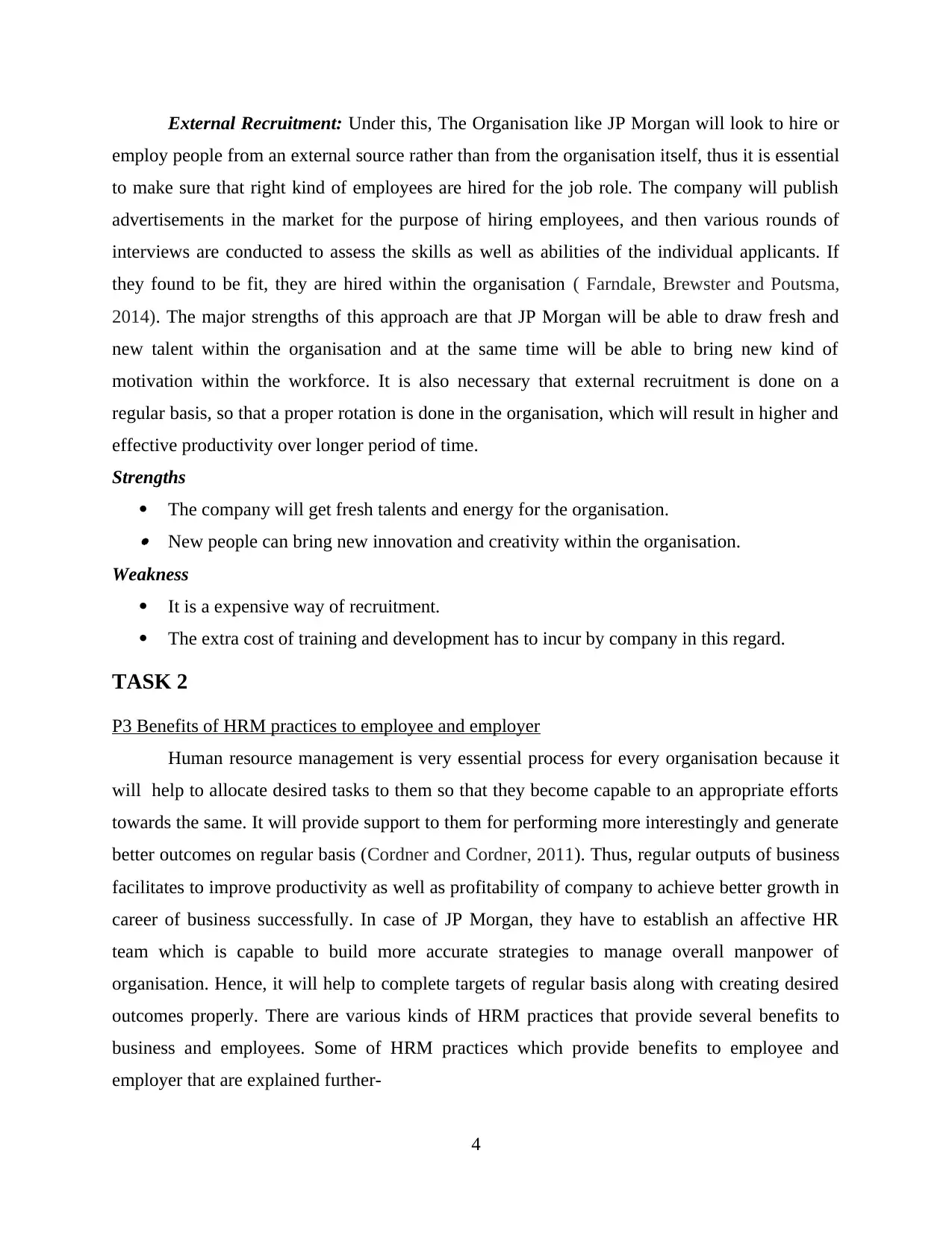
External Recruitment: Under this, The Organisation like JP Morgan will look to hire or
employ people from an external source rather than from the organisation itself, thus it is essential
to make sure that right kind of employees are hired for the job role. The company will publish
advertisements in the market for the purpose of hiring employees, and then various rounds of
interviews are conducted to assess the skills as well as abilities of the individual applicants. If
they found to be fit, they are hired within the organisation ( Farndale, Brewster and Poutsma,
2014). The major strengths of this approach are that JP Morgan will be able to draw fresh and
new talent within the organisation and at the same time will be able to bring new kind of
motivation within the workforce. It is also necessary that external recruitment is done on a
regular basis, so that a proper rotation is done in the organisation, which will result in higher and
effective productivity over longer period of time.
Strengths
The company will get fresh talents and energy for the organisation. New people can bring new innovation and creativity within the organisation.
Weakness
It is a expensive way of recruitment.
The extra cost of training and development has to incur by company in this regard.
TASK 2
P3 Benefits of HRM practices to employee and employer
Human resource management is very essential process for every organisation because it
will help to allocate desired tasks to them so that they become capable to an appropriate efforts
towards the same. It will provide support to them for performing more interestingly and generate
better outcomes on regular basis (Cordner and Cordner, 2011). Thus, regular outputs of business
facilitates to improve productivity as well as profitability of company to achieve better growth in
career of business successfully. In case of JP Morgan, they have to establish an affective HR
team which is capable to build more accurate strategies to manage overall manpower of
organisation. Hence, it will help to complete targets of regular basis along with creating desired
outcomes properly. There are various kinds of HRM practices that provide several benefits to
business and employees. Some of HRM practices which provide benefits to employee and
employer that are explained further-
4
employ people from an external source rather than from the organisation itself, thus it is essential
to make sure that right kind of employees are hired for the job role. The company will publish
advertisements in the market for the purpose of hiring employees, and then various rounds of
interviews are conducted to assess the skills as well as abilities of the individual applicants. If
they found to be fit, they are hired within the organisation ( Farndale, Brewster and Poutsma,
2014). The major strengths of this approach are that JP Morgan will be able to draw fresh and
new talent within the organisation and at the same time will be able to bring new kind of
motivation within the workforce. It is also necessary that external recruitment is done on a
regular basis, so that a proper rotation is done in the organisation, which will result in higher and
effective productivity over longer period of time.
Strengths
The company will get fresh talents and energy for the organisation. New people can bring new innovation and creativity within the organisation.
Weakness
It is a expensive way of recruitment.
The extra cost of training and development has to incur by company in this regard.
TASK 2
P3 Benefits of HRM practices to employee and employer
Human resource management is very essential process for every organisation because it
will help to allocate desired tasks to them so that they become capable to an appropriate efforts
towards the same. It will provide support to them for performing more interestingly and generate
better outcomes on regular basis (Cordner and Cordner, 2011). Thus, regular outputs of business
facilitates to improve productivity as well as profitability of company to achieve better growth in
career of business successfully. In case of JP Morgan, they have to establish an affective HR
team which is capable to build more accurate strategies to manage overall manpower of
organisation. Hence, it will help to complete targets of regular basis along with creating desired
outcomes properly. There are various kinds of HRM practices that provide several benefits to
business and employees. Some of HRM practices which provide benefits to employee and
employer that are explained further-
4
⊘ This is a preview!⊘
Do you want full access?
Subscribe today to unlock all pages.

Trusted by 1+ million students worldwide
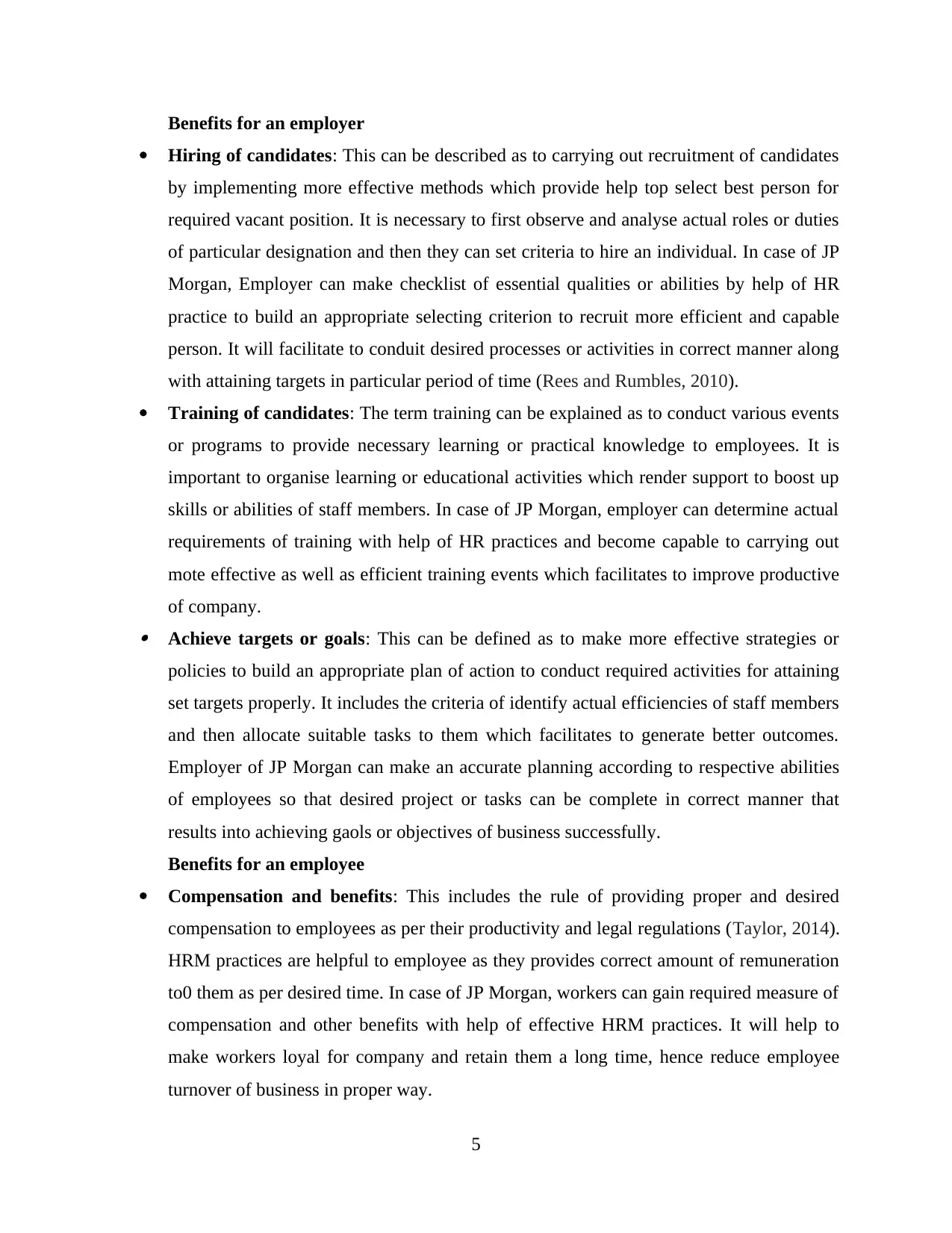
Benefits for an employer
Hiring of candidates: This can be described as to carrying out recruitment of candidates
by implementing more effective methods which provide help top select best person for
required vacant position. It is necessary to first observe and analyse actual roles or duties
of particular designation and then they can set criteria to hire an individual. In case of JP
Morgan, Employer can make checklist of essential qualities or abilities by help of HR
practice to build an appropriate selecting criterion to recruit more efficient and capable
person. It will facilitate to conduit desired processes or activities in correct manner along
with attaining targets in particular period of time (Rees and Rumbles, 2010).
Training of candidates: The term training can be explained as to conduct various events
or programs to provide necessary learning or practical knowledge to employees. It is
important to organise learning or educational activities which render support to boost up
skills or abilities of staff members. In case of JP Morgan, employer can determine actual
requirements of training with help of HR practices and become capable to carrying out
mote effective as well as efficient training events which facilitates to improve productive
of company. Achieve targets or goals: This can be defined as to make more effective strategies or
policies to build an appropriate plan of action to conduct required activities for attaining
set targets properly. It includes the criteria of identify actual efficiencies of staff members
and then allocate suitable tasks to them which facilitates to generate better outcomes.
Employer of JP Morgan can make an accurate planning according to respective abilities
of employees so that desired project or tasks can be complete in correct manner that
results into achieving gaols or objectives of business successfully.
Benefits for an employee
Compensation and benefits: This includes the rule of providing proper and desired
compensation to employees as per their productivity and legal regulations (Taylor, 2014).
HRM practices are helpful to employee as they provides correct amount of remuneration
to0 them as per desired time. In case of JP Morgan, workers can gain required measure of
compensation and other benefits with help of effective HRM practices. It will help to
make workers loyal for company and retain them a long time, hence reduce employee
turnover of business in proper way.
5
Hiring of candidates: This can be described as to carrying out recruitment of candidates
by implementing more effective methods which provide help top select best person for
required vacant position. It is necessary to first observe and analyse actual roles or duties
of particular designation and then they can set criteria to hire an individual. In case of JP
Morgan, Employer can make checklist of essential qualities or abilities by help of HR
practice to build an appropriate selecting criterion to recruit more efficient and capable
person. It will facilitate to conduit desired processes or activities in correct manner along
with attaining targets in particular period of time (Rees and Rumbles, 2010).
Training of candidates: The term training can be explained as to conduct various events
or programs to provide necessary learning or practical knowledge to employees. It is
important to organise learning or educational activities which render support to boost up
skills or abilities of staff members. In case of JP Morgan, employer can determine actual
requirements of training with help of HR practices and become capable to carrying out
mote effective as well as efficient training events which facilitates to improve productive
of company. Achieve targets or goals: This can be defined as to make more effective strategies or
policies to build an appropriate plan of action to conduct required activities for attaining
set targets properly. It includes the criteria of identify actual efficiencies of staff members
and then allocate suitable tasks to them which facilitates to generate better outcomes.
Employer of JP Morgan can make an accurate planning according to respective abilities
of employees so that desired project or tasks can be complete in correct manner that
results into achieving gaols or objectives of business successfully.
Benefits for an employee
Compensation and benefits: This includes the rule of providing proper and desired
compensation to employees as per their productivity and legal regulations (Taylor, 2014).
HRM practices are helpful to employee as they provides correct amount of remuneration
to0 them as per desired time. In case of JP Morgan, workers can gain required measure of
compensation and other benefits with help of effective HRM practices. It will help to
make workers loyal for company and retain them a long time, hence reduce employee
turnover of business in proper way.
5
Paraphrase This Document
Need a fresh take? Get an instant paraphrase of this document with our AI Paraphraser
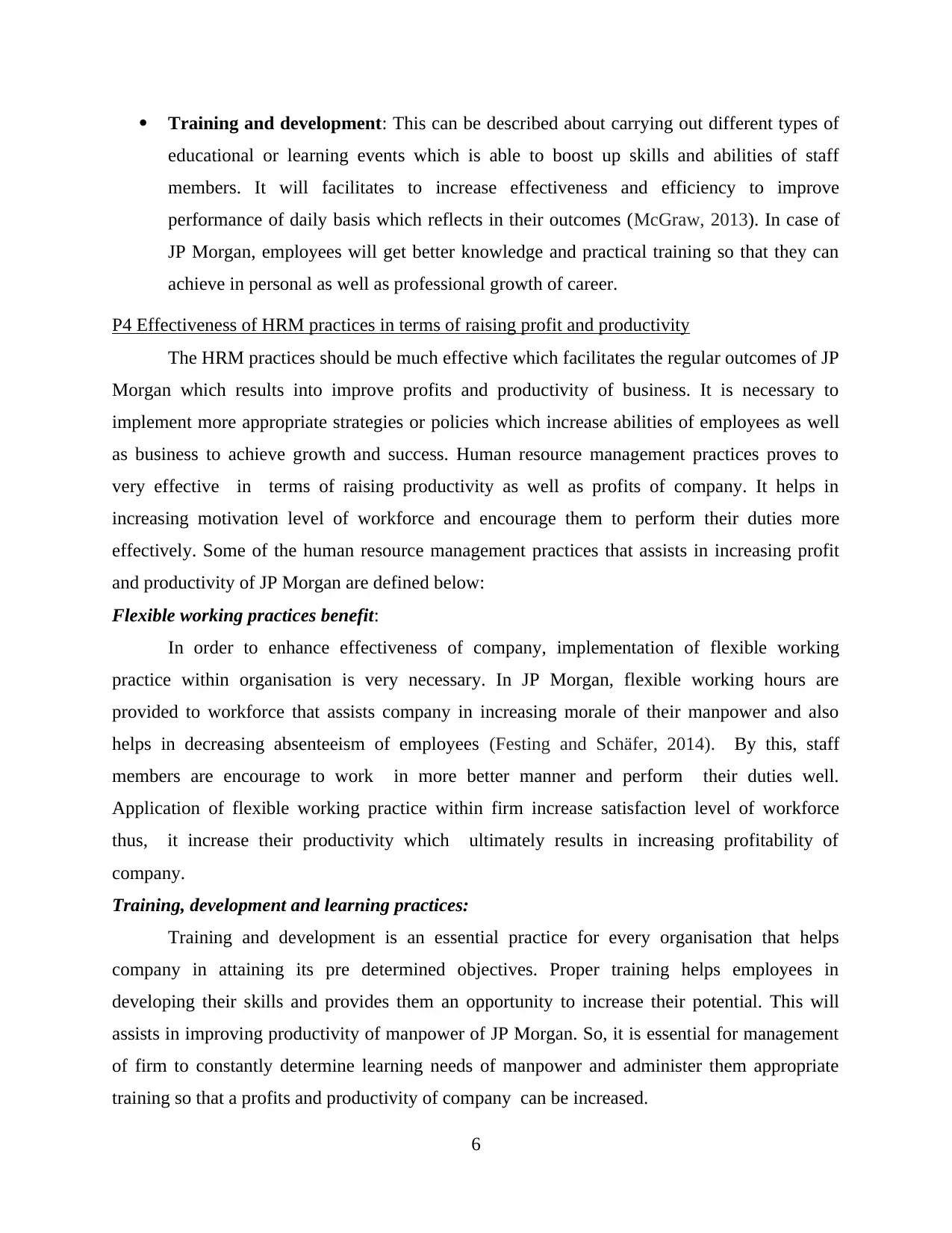
Training and development: This can be described about carrying out different types of
educational or learning events which is able to boost up skills and abilities of staff
members. It will facilitates to increase effectiveness and efficiency to improve
performance of daily basis which reflects in their outcomes (McGraw, 2013). In case of
JP Morgan, employees will get better knowledge and practical training so that they can
achieve in personal as well as professional growth of career.
P4 Effectiveness of HRM practices in terms of raising profit and productivity
The HRM practices should be much effective which facilitates the regular outcomes of JP
Morgan which results into improve profits and productivity of business. It is necessary to
implement more appropriate strategies or policies which increase abilities of employees as well
as business to achieve growth and success. Human resource management practices proves to
very effective in terms of raising productivity as well as profits of company. It helps in
increasing motivation level of workforce and encourage them to perform their duties more
effectively. Some of the human resource management practices that assists in increasing profit
and productivity of JP Morgan are defined below:
Flexible working practices benefit:
In order to enhance effectiveness of company, implementation of flexible working
practice within organisation is very necessary. In JP Morgan, flexible working hours are
provided to workforce that assists company in increasing morale of their manpower and also
helps in decreasing absenteeism of employees (Festing and Schäfer, 2014). By this, staff
members are encourage to work in more better manner and perform their duties well.
Application of flexible working practice within firm increase satisfaction level of workforce
thus, it increase their productivity which ultimately results in increasing profitability of
company.
Training, development and learning practices:
Training and development is an essential practice for every organisation that helps
company in attaining its pre determined objectives. Proper training helps employees in
developing their skills and provides them an opportunity to increase their potential. This will
assists in improving productivity of manpower of JP Morgan. So, it is essential for management
of firm to constantly determine learning needs of manpower and administer them appropriate
training so that a profits and productivity of company can be increased.
6
educational or learning events which is able to boost up skills and abilities of staff
members. It will facilitates to increase effectiveness and efficiency to improve
performance of daily basis which reflects in their outcomes (McGraw, 2013). In case of
JP Morgan, employees will get better knowledge and practical training so that they can
achieve in personal as well as professional growth of career.
P4 Effectiveness of HRM practices in terms of raising profit and productivity
The HRM practices should be much effective which facilitates the regular outcomes of JP
Morgan which results into improve profits and productivity of business. It is necessary to
implement more appropriate strategies or policies which increase abilities of employees as well
as business to achieve growth and success. Human resource management practices proves to
very effective in terms of raising productivity as well as profits of company. It helps in
increasing motivation level of workforce and encourage them to perform their duties more
effectively. Some of the human resource management practices that assists in increasing profit
and productivity of JP Morgan are defined below:
Flexible working practices benefit:
In order to enhance effectiveness of company, implementation of flexible working
practice within organisation is very necessary. In JP Morgan, flexible working hours are
provided to workforce that assists company in increasing morale of their manpower and also
helps in decreasing absenteeism of employees (Festing and Schäfer, 2014). By this, staff
members are encourage to work in more better manner and perform their duties well.
Application of flexible working practice within firm increase satisfaction level of workforce
thus, it increase their productivity which ultimately results in increasing profitability of
company.
Training, development and learning practices:
Training and development is an essential practice for every organisation that helps
company in attaining its pre determined objectives. Proper training helps employees in
developing their skills and provides them an opportunity to increase their potential. This will
assists in improving productivity of manpower of JP Morgan. So, it is essential for management
of firm to constantly determine learning needs of manpower and administer them appropriate
training so that a profits and productivity of company can be increased.
6
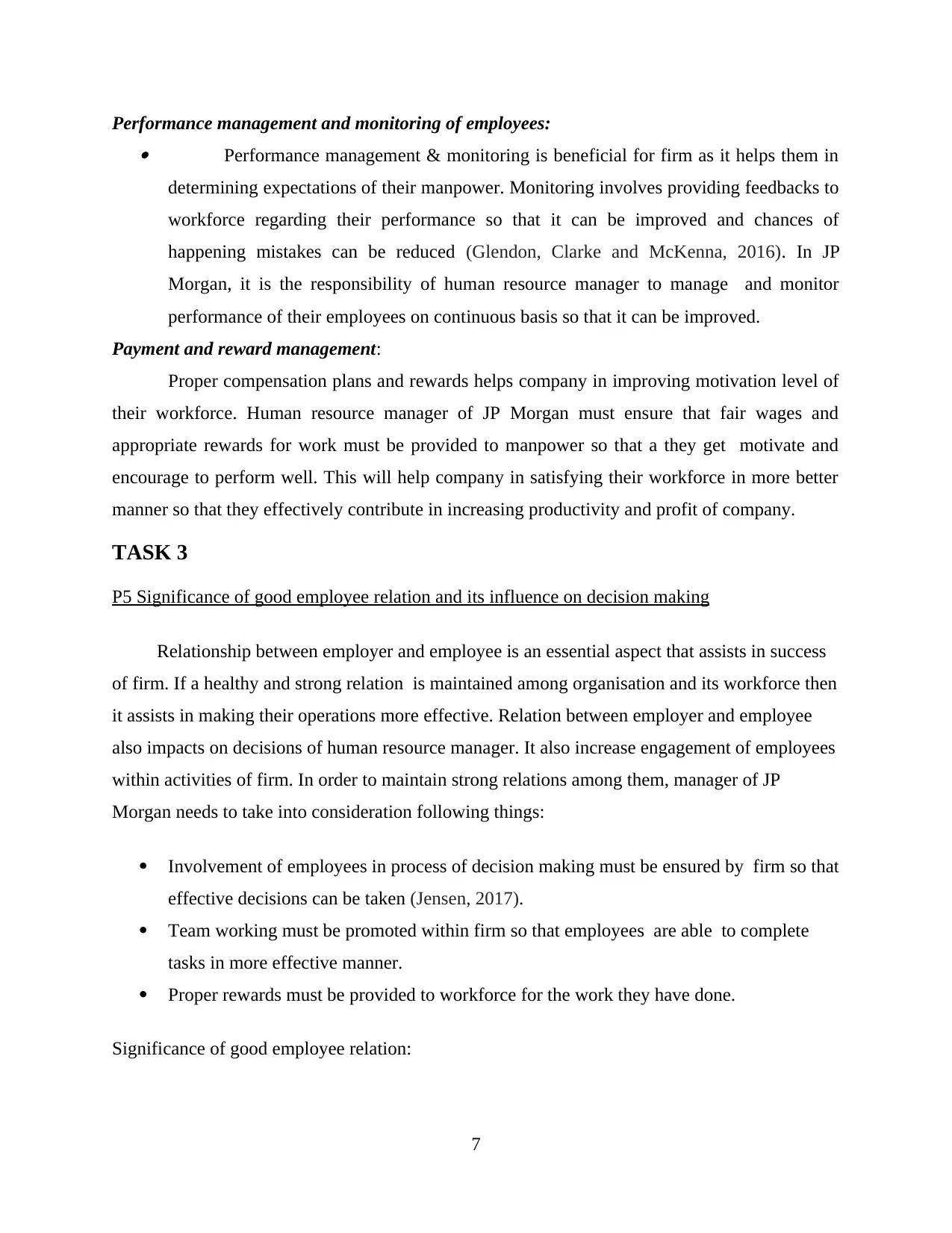
Performance management and monitoring of employees: Performance management & monitoring is beneficial for firm as it helps them in
determining expectations of their manpower. Monitoring involves providing feedbacks to
workforce regarding their performance so that it can be improved and chances of
happening mistakes can be reduced (Glendon, Clarke and McKenna, 2016). In JP
Morgan, it is the responsibility of human resource manager to manage and monitor
performance of their employees on continuous basis so that it can be improved.
Payment and reward management:
Proper compensation plans and rewards helps company in improving motivation level of
their workforce. Human resource manager of JP Morgan must ensure that fair wages and
appropriate rewards for work must be provided to manpower so that a they get motivate and
encourage to perform well. This will help company in satisfying their workforce in more better
manner so that they effectively contribute in increasing productivity and profit of company.
TASK 3
P5 Significance of good employee relation and its influence on decision making
Relationship between employer and employee is an essential aspect that assists in success
of firm. If a healthy and strong relation is maintained among organisation and its workforce then
it assists in making their operations more effective. Relation between employer and employee
also impacts on decisions of human resource manager. It also increase engagement of employees
within activities of firm. In order to maintain strong relations among them, manager of JP
Morgan needs to take into consideration following things:
Involvement of employees in process of decision making must be ensured by firm so that
effective decisions can be taken (Jensen, 2017).
Team working must be promoted within firm so that employees are able to complete
tasks in more effective manner.
Proper rewards must be provided to workforce for the work they have done.
Significance of good employee relation:
7
determining expectations of their manpower. Monitoring involves providing feedbacks to
workforce regarding their performance so that it can be improved and chances of
happening mistakes can be reduced (Glendon, Clarke and McKenna, 2016). In JP
Morgan, it is the responsibility of human resource manager to manage and monitor
performance of their employees on continuous basis so that it can be improved.
Payment and reward management:
Proper compensation plans and rewards helps company in improving motivation level of
their workforce. Human resource manager of JP Morgan must ensure that fair wages and
appropriate rewards for work must be provided to manpower so that a they get motivate and
encourage to perform well. This will help company in satisfying their workforce in more better
manner so that they effectively contribute in increasing productivity and profit of company.
TASK 3
P5 Significance of good employee relation and its influence on decision making
Relationship between employer and employee is an essential aspect that assists in success
of firm. If a healthy and strong relation is maintained among organisation and its workforce then
it assists in making their operations more effective. Relation between employer and employee
also impacts on decisions of human resource manager. It also increase engagement of employees
within activities of firm. In order to maintain strong relations among them, manager of JP
Morgan needs to take into consideration following things:
Involvement of employees in process of decision making must be ensured by firm so that
effective decisions can be taken (Jensen, 2017).
Team working must be promoted within firm so that employees are able to complete
tasks in more effective manner.
Proper rewards must be provided to workforce for the work they have done.
Significance of good employee relation:
7
⊘ This is a preview!⊘
Do you want full access?
Subscribe today to unlock all pages.

Trusted by 1+ million students worldwide

Good employee relation assists in increasing motivation level of manpower which in turn
results in accomplishment of goals and objectives of company. If employee relations are
good, managers are not require to put much effort on recruitment and selection process as
employee turnover of firm is low.
It helps in promoting healthy work environment which enables employees to work in
more better manner. Existence of healthy surroundings at workplace assists HR manager
in planning effective training programmes for manpower.
It supports in increasing profitability and performance of both workforce as well as
organisation. Good performance of firm makes it easy for human resource manager in
promoting good image of organisation among customers.
Significance of trade union within organisation:
Trade Union: It refers to an organization whose membership constitute of group of union
leaders and workers to protect & promote their common interest. It is also known as Labour
Union. In general, under this workers are collectively come together to attain common goal; for
example: enhancing safety standards, securing the integrity of trade, working condition and
achieving better benefits and wages by the creation of monopoly of workers. Basically the role of
trade union is to bargain with employer on the behalf of union members (employees) & negotiate
labour contracts with employers (Kavanagh and Johnson, 2017). The main objective of these
association is to “improve and maintain healthy employment condition” i.e. effectively taking
care of both personal and professional interest of union workers. The key importance of Trade
Union are mentioned below:
With collective voice, there is a positive effect of higher productivity which can be seen
in the performance of union members.
It also help in providing better terms and condition of employment and also creates
healthy working environment.
Trade union works for protecting the interest of workforce and negotiate on the behalf of
team. It constantly strives for welfare of its team members.
8
results in accomplishment of goals and objectives of company. If employee relations are
good, managers are not require to put much effort on recruitment and selection process as
employee turnover of firm is low.
It helps in promoting healthy work environment which enables employees to work in
more better manner. Existence of healthy surroundings at workplace assists HR manager
in planning effective training programmes for manpower.
It supports in increasing profitability and performance of both workforce as well as
organisation. Good performance of firm makes it easy for human resource manager in
promoting good image of organisation among customers.
Significance of trade union within organisation:
Trade Union: It refers to an organization whose membership constitute of group of union
leaders and workers to protect & promote their common interest. It is also known as Labour
Union. In general, under this workers are collectively come together to attain common goal; for
example: enhancing safety standards, securing the integrity of trade, working condition and
achieving better benefits and wages by the creation of monopoly of workers. Basically the role of
trade union is to bargain with employer on the behalf of union members (employees) & negotiate
labour contracts with employers (Kavanagh and Johnson, 2017). The main objective of these
association is to “improve and maintain healthy employment condition” i.e. effectively taking
care of both personal and professional interest of union workers. The key importance of Trade
Union are mentioned below:
With collective voice, there is a positive effect of higher productivity which can be seen
in the performance of union members.
It also help in providing better terms and condition of employment and also creates
healthy working environment.
Trade union works for protecting the interest of workforce and negotiate on the behalf of
team. It constantly strives for welfare of its team members.
8
Paraphrase This Document
Need a fresh take? Get an instant paraphrase of this document with our AI Paraphraser
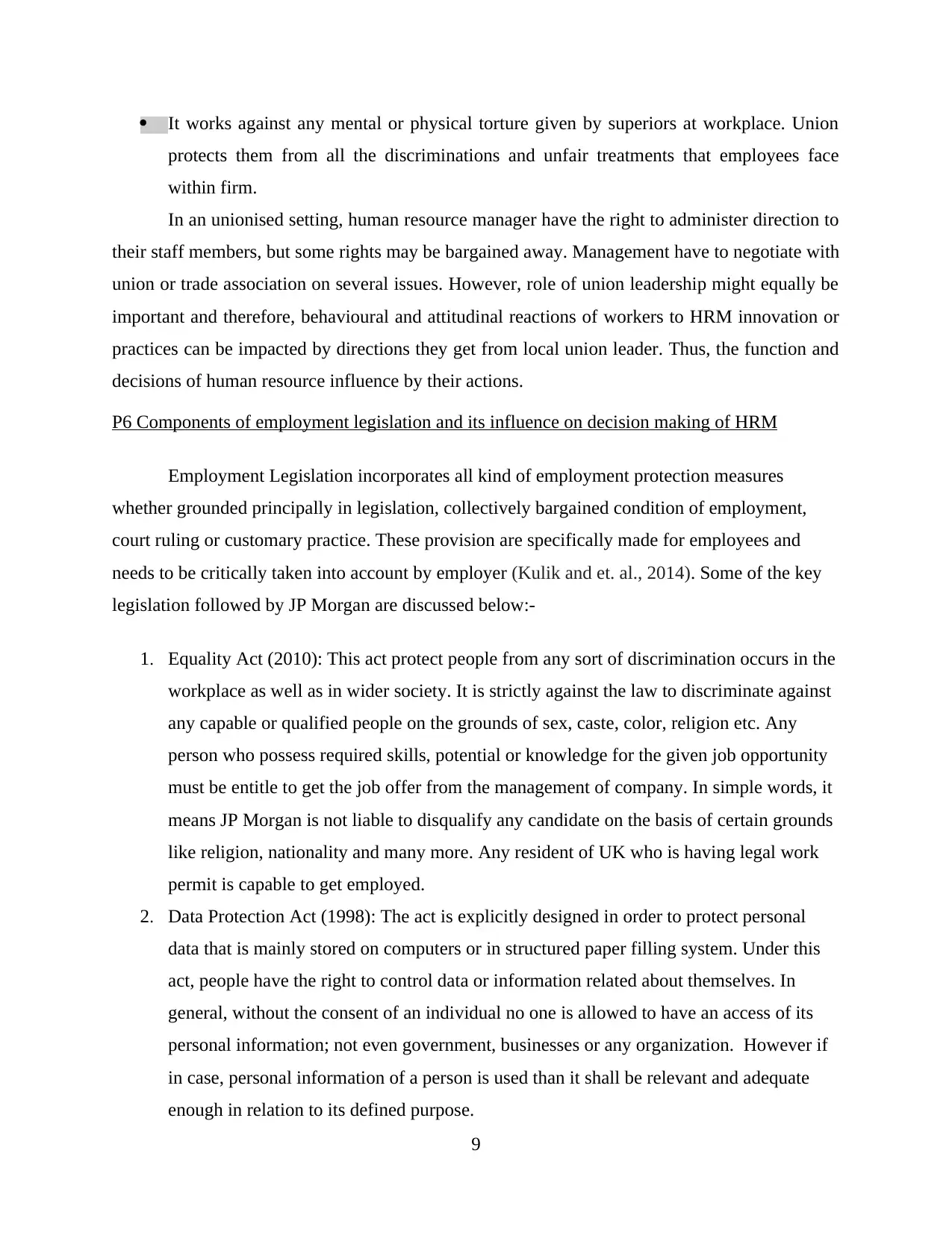
It works against any mental or physical torture given by superiors at workplace. Union
protects them from all the discriminations and unfair treatments that employees face
within firm.
In an unionised setting, human resource manager have the right to administer direction to
their staff members, but some rights may be bargained away. Management have to negotiate with
union or trade association on several issues. However, role of union leadership might equally be
important and therefore, behavioural and attitudinal reactions of workers to HRM innovation or
practices can be impacted by directions they get from local union leader. Thus, the function and
decisions of human resource influence by their actions.
P6 Components of employment legislation and its influence on decision making of HRM
Employment Legislation incorporates all kind of employment protection measures
whether grounded principally in legislation, collectively bargained condition of employment,
court ruling or customary practice. These provision are specifically made for employees and
needs to be critically taken into account by employer (Kulik and et. al., 2014). Some of the key
legislation followed by JP Morgan are discussed below:-
1. Equality Act (2010): This act protect people from any sort of discrimination occurs in the
workplace as well as in wider society. It is strictly against the law to discriminate against
any capable or qualified people on the grounds of sex, caste, color, religion etc. Any
person who possess required skills, potential or knowledge for the given job opportunity
must be entitle to get the job offer from the management of company. In simple words, it
means JP Morgan is not liable to disqualify any candidate on the basis of certain grounds
like religion, nationality and many more. Any resident of UK who is having legal work
permit is capable to get employed.
2. Data Protection Act (1998): The act is explicitly designed in order to protect personal
data that is mainly stored on computers or in structured paper filling system. Under this
act, people have the right to control data or information related about themselves. In
general, without the consent of an individual no one is allowed to have an access of its
personal information; not even government, businesses or any organization. However if
in case, personal information of a person is used than it shall be relevant and adequate
enough in relation to its defined purpose.
9
protects them from all the discriminations and unfair treatments that employees face
within firm.
In an unionised setting, human resource manager have the right to administer direction to
their staff members, but some rights may be bargained away. Management have to negotiate with
union or trade association on several issues. However, role of union leadership might equally be
important and therefore, behavioural and attitudinal reactions of workers to HRM innovation or
practices can be impacted by directions they get from local union leader. Thus, the function and
decisions of human resource influence by their actions.
P6 Components of employment legislation and its influence on decision making of HRM
Employment Legislation incorporates all kind of employment protection measures
whether grounded principally in legislation, collectively bargained condition of employment,
court ruling or customary practice. These provision are specifically made for employees and
needs to be critically taken into account by employer (Kulik and et. al., 2014). Some of the key
legislation followed by JP Morgan are discussed below:-
1. Equality Act (2010): This act protect people from any sort of discrimination occurs in the
workplace as well as in wider society. It is strictly against the law to discriminate against
any capable or qualified people on the grounds of sex, caste, color, religion etc. Any
person who possess required skills, potential or knowledge for the given job opportunity
must be entitle to get the job offer from the management of company. In simple words, it
means JP Morgan is not liable to disqualify any candidate on the basis of certain grounds
like religion, nationality and many more. Any resident of UK who is having legal work
permit is capable to get employed.
2. Data Protection Act (1998): The act is explicitly designed in order to protect personal
data that is mainly stored on computers or in structured paper filling system. Under this
act, people have the right to control data or information related about themselves. In
general, without the consent of an individual no one is allowed to have an access of its
personal information; not even government, businesses or any organization. However if
in case, personal information of a person is used than it shall be relevant and adequate
enough in relation to its defined purpose.
9
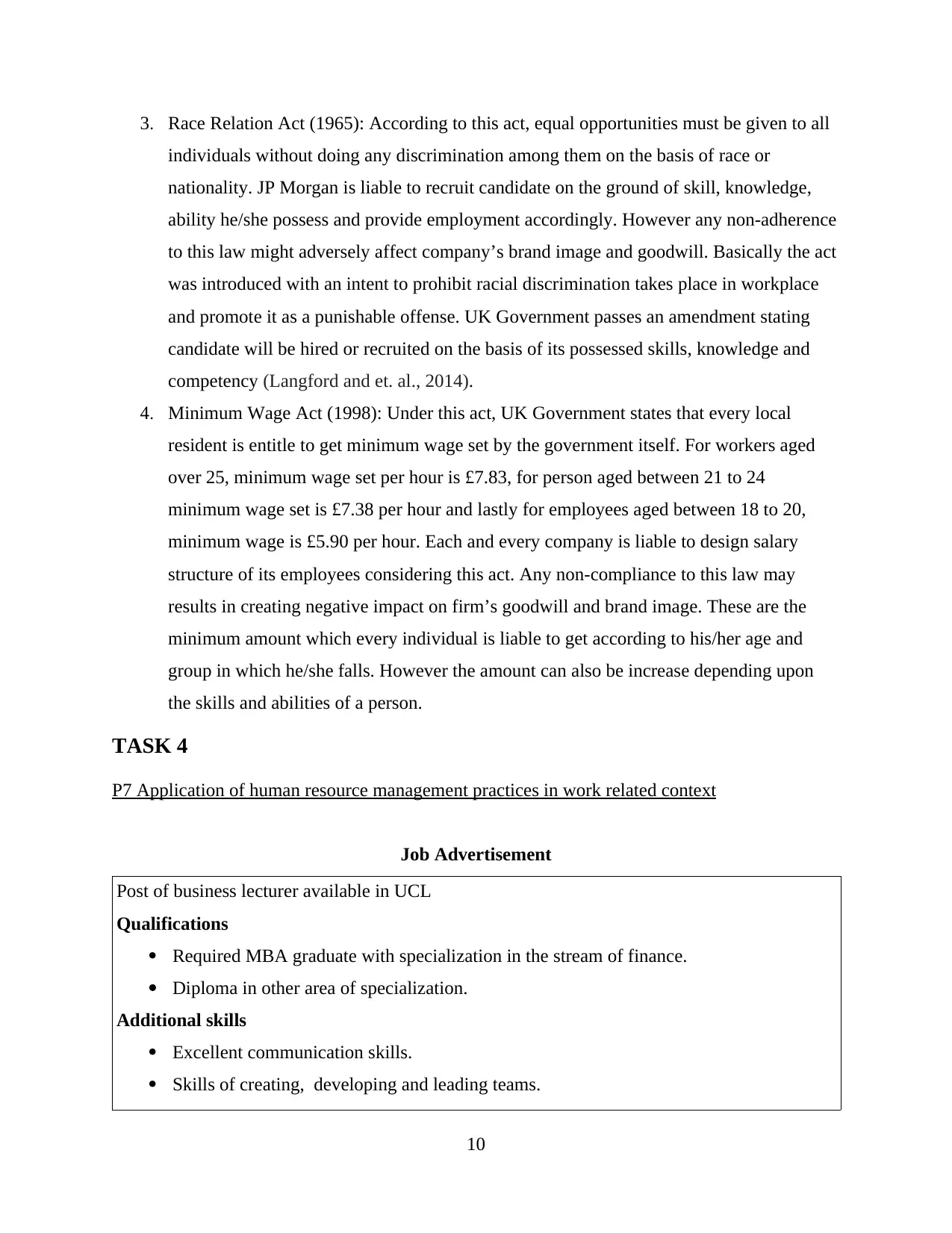
3. Race Relation Act (1965): According to this act, equal opportunities must be given to all
individuals without doing any discrimination among them on the basis of race or
nationality. JP Morgan is liable to recruit candidate on the ground of skill, knowledge,
ability he/she possess and provide employment accordingly. However any non-adherence
to this law might adversely affect company’s brand image and goodwill. Basically the act
was introduced with an intent to prohibit racial discrimination takes place in workplace
and promote it as a punishable offense. UK Government passes an amendment stating
candidate will be hired or recruited on the basis of its possessed skills, knowledge and
competency (Langford and et. al., 2014).
4. Minimum Wage Act (1998): Under this act, UK Government states that every local
resident is entitle to get minimum wage set by the government itself. For workers aged
over 25, minimum wage set per hour is £7.83, for person aged between 21 to 24
minimum wage set is £7.38 per hour and lastly for employees aged between 18 to 20,
minimum wage is £5.90 per hour. Each and every company is liable to design salary
structure of its employees considering this act. Any non-compliance to this law may
results in creating negative impact on firm’s goodwill and brand image. These are the
minimum amount which every individual is liable to get according to his/her age and
group in which he/she falls. However the amount can also be increase depending upon
the skills and abilities of a person.
TASK 4
P7 Application of human resource management practices in work related context
Job Advertisement
Post of business lecturer available in UCL
Qualifications
Required MBA graduate with specialization in the stream of finance.
Diploma in other area of specialization.
Additional skills
Excellent communication skills.
Skills of creating, developing and leading teams.
10
individuals without doing any discrimination among them on the basis of race or
nationality. JP Morgan is liable to recruit candidate on the ground of skill, knowledge,
ability he/she possess and provide employment accordingly. However any non-adherence
to this law might adversely affect company’s brand image and goodwill. Basically the act
was introduced with an intent to prohibit racial discrimination takes place in workplace
and promote it as a punishable offense. UK Government passes an amendment stating
candidate will be hired or recruited on the basis of its possessed skills, knowledge and
competency (Langford and et. al., 2014).
4. Minimum Wage Act (1998): Under this act, UK Government states that every local
resident is entitle to get minimum wage set by the government itself. For workers aged
over 25, minimum wage set per hour is £7.83, for person aged between 21 to 24
minimum wage set is £7.38 per hour and lastly for employees aged between 18 to 20,
minimum wage is £5.90 per hour. Each and every company is liable to design salary
structure of its employees considering this act. Any non-compliance to this law may
results in creating negative impact on firm’s goodwill and brand image. These are the
minimum amount which every individual is liable to get according to his/her age and
group in which he/she falls. However the amount can also be increase depending upon
the skills and abilities of a person.
TASK 4
P7 Application of human resource management practices in work related context
Job Advertisement
Post of business lecturer available in UCL
Qualifications
Required MBA graduate with specialization in the stream of finance.
Diploma in other area of specialization.
Additional skills
Excellent communication skills.
Skills of creating, developing and leading teams.
10
⊘ This is a preview!⊘
Do you want full access?
Subscribe today to unlock all pages.

Trusted by 1+ million students worldwide
1 out of 16
Related Documents
Your All-in-One AI-Powered Toolkit for Academic Success.
+13062052269
info@desklib.com
Available 24*7 on WhatsApp / Email
![[object Object]](/_next/static/media/star-bottom.7253800d.svg)
Unlock your academic potential
Copyright © 2020–2025 A2Z Services. All Rights Reserved. Developed and managed by ZUCOL.





